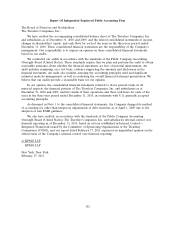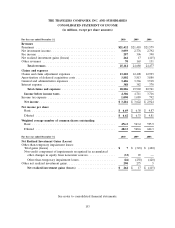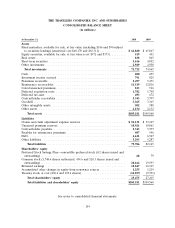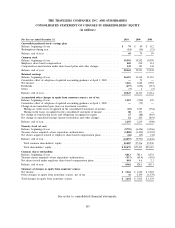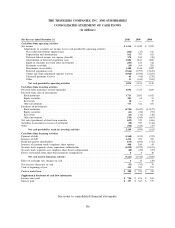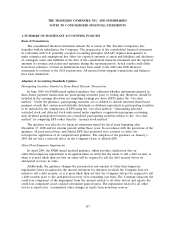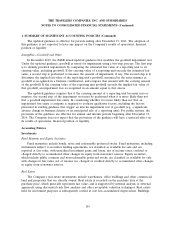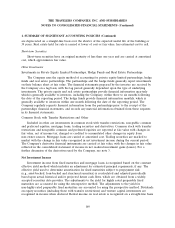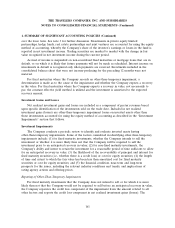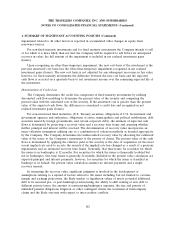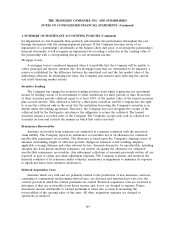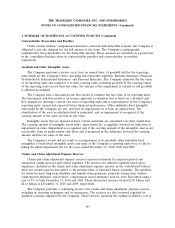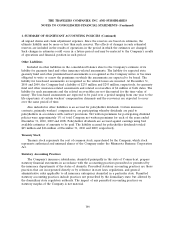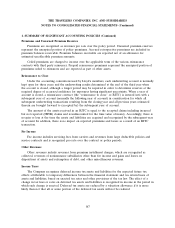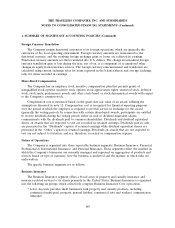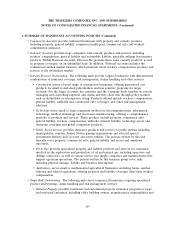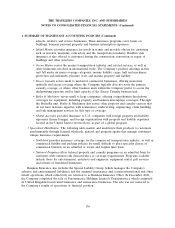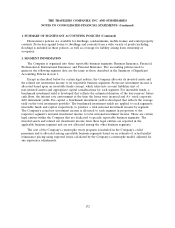Travelers 2010 Annual Report Download - page 174
Download and view the complete annual report
Please find page 174 of the 2010 Travelers annual report below. You can navigate through the pages in the report by either clicking on the pages listed below, or by using the keyword search tool below to find specific information within the annual report.THE TRAVELERS COMPANIES, INC. AND SUBSIDIARIES
NOTES TO CONSOLIDATED FINANCIAL STATEMENTS (Continued)
1. SUMMARY OF SIGNIFICANT ACCOUNTING POLICIES (Continued)
impairment related to all other factors is reported in accumulated other changes in equity from
nonowner sources.
For non-fixed maturity investments and for fixed maturity investments the Company intends to sell
or for which it is more likely than not that the Company will be required to sell before an anticipated
recovery in value, the full amount of the impairment is included in net realized investment gains
(losses).
Upon recognizing an other-than-temporary impairment, the new cost basis of the investment is the
previous amortized cost basis less the other-than-temporary impairment recognized in net realized
investment gains (losses). The new cost basis is not adjusted for any subsequent recoveries in fair value;
however, for fixed maturity investments the difference between the new cost basis and the expected
cash flows is accreted on a quarterly basis to net investment income over the remaining expected life of
the investment.
Determination of Credit Loss
The Company determines the credit loss component of fixed maturity investments by utilizing
discounted cash flow modeling to determine the present value of the security and comparing the
present value with the amortized cost of the security. If the amortized cost is greater than the present
value of the expected cash flows, the difference is considered a credit loss and recognized in net
realized investment gains (losses).
For non-structured fixed maturities (U.S. Treasury securities, obligations of U.S. Government and
government agencies and authorities, obligations of states, municipalities and political subdivisions, debt
securities issued by foreign governments, and certain corporate debt), the estimate of expected cash
flows is determined by projecting a recovery value and a recovery time frame and assessing whether
further principal and interest will be received. The determination of recovery value incorporates an
issuer valuation assumption utilizing one or a combination of valuation methods as deemed appropriate
by the Company. The Company determines the undiscounted recovery value by allocating the estimated
value of the issuer to the Company’s assessment of the priority of claims. The present value of the cash
flows is determined by applying the effective yield of the security at the date of acquisition (or the most
recent implied rate used to accrete the security if the implied rate has changed as a result of a previous
impairment) and an estimated recovery time frame. Generally, that time frame for securities for which
the issuer is in bankruptcy is 12 months. For securities for which the issuer is financially troubled but
not in bankruptcy, that time frame is generally 24 months. Included in the present value calculation are
expected principal and interest payments; however, for securities for which the issuer is classified as
bankrupt or in default, the present value calculation assumes no interest payments and a single
recovery amount.
In estimating the recovery value, significant judgment is involved in the development of
assumptions relating to a myriad of factors related to the issuer including, but not limited to, revenue,
margin and earnings projections, the likely market or liquidation values of assets, potential additional
debt to be incurred pre- or post-bankruptcy/restructuring, the ability to shift existing or new debt to
different priority layers, the amount of restructuring/bankruptcy expenses, the size and priority of
unfunded pension obligations, litigation or other contingent claims, the treatment of intercompany
claims and the likely outcome with respect to inter-creditor conflicts.
162


